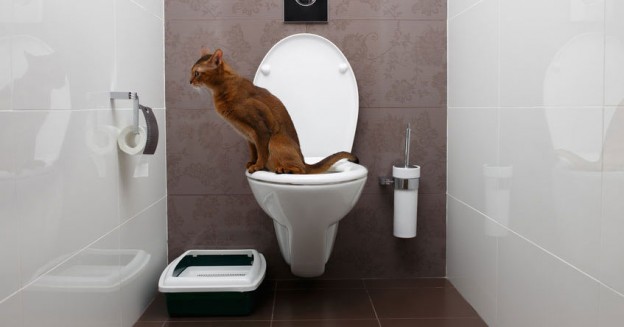Never Flush Cat Poop Down Your Toilet - Protect Your Plumbing System
Never Flush Cat Poop Down Your Toilet - Protect Your Plumbing System
Blog Article
We have found this post involving Can You Flush Cat Poo or Litter Down the Toilet? down the page on the net and concluded it made good sense to share it with you here.

Intro
As cat proprietors, it's essential to be mindful of how we deal with our feline pals' waste. While it may appear hassle-free to flush feline poop down the toilet, this technique can have damaging consequences for both the atmosphere and human health.
Environmental Impact
Flushing feline poop introduces dangerous virus and bloodsuckers right into the water, posing a substantial threat to marine ecological communities. These impurities can adversely impact aquatic life and compromise water quality.
Health Risks
Along with ecological problems, purging feline waste can likewise position health threats to human beings. Cat feces might have Toxoplasma gondii, a bloodsucker that can trigger toxoplasmosis-- a possibly severe health problem, particularly for expectant women and individuals with damaged immune systems.
Alternatives to Flushing
Luckily, there are safer and extra liable methods to throw away cat poop. Consider the complying with alternatives:
1. Scoop and Dispose in Trash
One of the most typical approach of disposing of pet cat poop is to scoop it right into a biodegradable bag and toss it in the garbage. Make sure to use a committed clutter inside story and get rid of the waste quickly.
2. Usage Biodegradable Litter
Choose biodegradable feline litter made from products such as corn or wheat. These trashes are environmentally friendly and can be safely dealt with in the garbage.
3. Bury in the Yard
If you have a lawn, consider hiding cat waste in an assigned location away from vegetable gardens and water sources. Make sure to dig deep enough to avoid contamination of groundwater.
4. Mount a Pet Waste Disposal System
Purchase a pet dog waste disposal system especially developed for pet cat waste. These systems use enzymes to break down the waste, lowering smell and environmental influence.
Conclusion
Liable animal ownership expands beyond giving food and sanctuary-- it also includes proper waste monitoring. By refraining from flushing feline poop down the commode and opting for alternate disposal approaches, we can minimize our environmental impact and protect human health.
Why Can’t I Flush Cat Poop?
It Spreads a Parasite
Cats are frequently infected with a parasite called toxoplasma gondii. The parasite causes an infection called toxoplasmosis. It is usually harmless to cats. The parasite only uses cat poop as a host for its eggs. Otherwise, the cat’s immune system usually keeps the infection at low enough levels to maintain its own health. But it does not stop the develop of eggs. These eggs are tiny and surprisingly tough. They may survive for a year before they begin to grow. But that’s the problem.
Our wastewater system is not designed to deal with toxoplasmosis eggs. Instead, most eggs will flush from your toilet into sewers and wastewater management plants. After the sewage is treated for many other harmful things in it, it is typically released into local rivers, lakes, or oceans. Here, the toxoplasmosis eggs can find new hosts, including starfish, crabs, otters, and many other wildlife. For many, this is a significant risk to their health. Toxoplasmosis can also end up infecting water sources that are important for agriculture, which means our deer, pigs, and sheep can get infected too.
Is There Risk to Humans?
There can be a risk to human life from flushing cat poop down the toilet. If you do so, the parasites from your cat’s poop can end up in shellfish, game animals, or livestock. If this meat is then served raw or undercooked, the people who eat it can get sick.
In fact, according to the CDC, 40 million people in the United States are infected with toxoplasma gondii. They get it from exposure to infected seafood, or from some kind of cat poop contamination, like drinking from a stream that is contaminated or touching anything that has come into contact with cat poop. That includes just cleaning a cat litter box.
Most people who get infected with these parasites will not develop any symptoms. However, for pregnant women or for those with compromised immune systems, the parasite can cause severe health problems.
How to Handle Cat Poop
The best way to handle cat poop is actually to clean the box more often. The eggs that the parasite sheds will not become active until one to five days after the cat poops. That means that if you clean daily, you’re much less likely to come into direct contact with infectious eggs.
That said, always dispose of cat poop in the garbage and not down the toilet. Wash your hands before and after you clean the litter box, and bring the bag of poop right outside to your garbage bins.
https://trenchlesssolutionsusa.com/why-cant-i-flush-cat-poop/

Do you enjoy reading up on How to Dispose of Cat Poop and Litter Without Plastic Bags? Write a remark down below. We would be interested to see your ideas about this blog post. We hope that you come back again later on. Are you aware of another individual who is involved in the subject? Feel free to promote it. Many thanks for taking the time to read it.
Contact Us Now Report this page